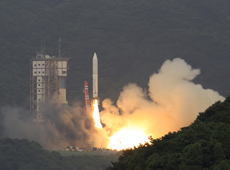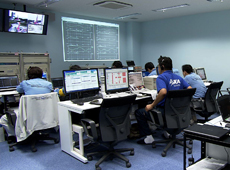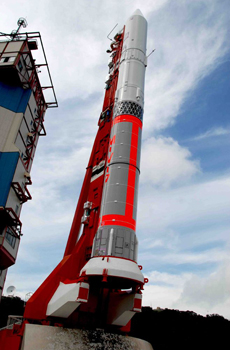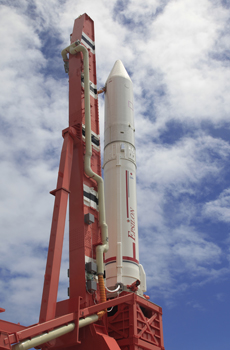
--- Did Epsilon turn out to be the kind of rocket you had hoped for?

Launch of the first Epsilon Launch Vehicle
At the press conference about the cancellation of the M-V launch vehicle, I said, “The M-V has the best performance in the world, but future rockets will not be able to compete based on performance alone, so we need to develop a new system that makes launching rockets easier.” I was able to stay true to these words, so I am satisfied with Epsilon-1 as a first step.
--- How did you feel when the rocket was launched successfully?
The entire team had worked so hard, I really wanted the launch to be a success, and I had a strong belief that we would succeed. When talking about the project in public, I sounded quite confident. Having said that, though, there were times when I could barely sleep at night, or felt discouraged, too, so I was truly relieved when I saw Epsilon taking off into space.
--- The launch was postponed twice. What went through your mind when that happened?
Epsilon’s greatest technological advance is its automatic and autonomous checking system. The basic concept is to prevent serious accidents by having a computer detect any human errors. However, the direct cause of the second postponement was a misalignment of operation timing between the computers. I regret that what the system detected was a simple human error. But it was a test flight at the development phase, and I am also genuinely glad that we were able to find the problem before launch.
The first postponement was due to a problem with the manufacturing plan. Ideally there would have been no such simple human errors. But even when they happen, the tests we run prior to launch will catch them. This system functioned well this time, but I hope that from now on we can spend less time on this process.
---- On August 27, many children came to observe the launch because they were still on summer break. Were you aware of this?
Actually, we were concentrating on our work in the control room, so we had no idea that so many people were there to see the event. We were very surprised when journalists told us about it later. I wonder if the success of the asteroid explorer HAYABUSA has made space more familiar to people. I have been saying that the purpose of the Epsilon program is to simplify the launch system in order to lower the threshold for accessing space and increase the number of rocket launches. But I was touched to find that people’s interest in space had surpassed our expectations, and that they were already feeling a closer connection with space. After the launch was put off for the second time, we sometimes faced criticism or concern, but we received three times as much support. We were able to launch the rocket thanks to people cheering us on. We are truly grateful for that.
--- How did you come up with the idea for mobile launch control?

Launch rehearsal in the control room
When the M-V launch vehicle was retired, I didn’t have a concrete idea about mobile control using personal computers. But ever since I started working on the M-V, I’d had a serious concern that there would be no future for space exploration unless rocket launches could be greatly simplified. And in the process of thinking about how to do that, the idea of mobile launch control using advanced IT technologies was born. This lead to the idea of creating an autonomous checking system using artificial intelligence. Cost reduction was imperative – the M-V was originally called off because of its relatively high cost of about 8 billion yen (80 million USD) per launch. Mobile launch control can greatly reduce that amount by cutting down the time and manpower required for launch preparation.
--- Why did it have to be a new solid-fuel rocket?
Space exploration and exploitation are now reaching a major turning point. The important keywords today are small size, high performance and low cost. For the advancement of space science in the future, and of space exploration and exploitation, it is essential to increase the number of rocket launches in order to expand opportunities. And we don’t have much choice but to pursue efficiency using not just large satellites but also small ones. Solid-fuel rockets have a simple structure, so they are ideal to meet the demands of a time like this.
--- Some people point out the risk that solid-fuel rockets can be diverted to military use. What do you think about that?
For us, they are not missiles but like the Thunderbirds, which are meant to be used for peaceful purposes. We are scientists, so we don’t think about the possibility of misuse of the Epsilon, but we don’t want to allow it to happen either.
--- What was the biggest challenge with Epsilon?

M-V launch vehicle, the world’s best-performing rocket
The toughest time was our four years of research starting 2006, before Epsilon was officially approved by the government. When we started talking about launching a rocket using just two personal computers, the strongest backlash actually came from within JAXA. Especially when it came to talking about reducing the number of people needed for the launch, I could sense that some people were thinking, “What will happen to our jobs?” We got a lot of criticism. People told us that such a project would be impossible, so we should just drop it. But despite all the negative reactions, we carried on, with a strong determination to create a rocket for the future. What’s important when you start something new is to explain it clearly and patiently, and you will gradually gain supporters. I am impressed that we made it though.
The Chinese characters for “SHIN” (meaning “new”) and “NEN” (meaning “burning”) are written on the cover of Epsilon’s performance calculations booklet. When read together as “SHIN-NEN” it sounds like the Japanese word for “faith” or “belief.” These words, in fact, represent those four years. When I was having a tough time, Dr. Ryojiro Akiba, who was my professor and also headed up Japan’s solid-fuel rocket research, said to me, “There is no ‘what if’ in the world of space exploration. Make a good rocket and open the door to the future.” His encouragement helped us make it this far, and helped us keep our faith in developing a better launch vehicle ever better than the M-V.
--- Those words of encouragement from your former professor were so powerful.
So powerful, indeed. Thanks to the encouragement of people like him, I was able to hold up against adverse winds. You cannot imagine how much Dr. Akiba’s words meant to me. He was the top student of Dr. Hideo Itokawa, who is called the father of Japanese rocketry. And I am a student of Dr. Akiba, so Dr. Itokawa’s spirit is also in me – the drive to not just catch up with, but overtake the rest of the world. In fact, the name Epsilon is significant: when you rotate the “M” of the M launch vehicle 90 degrees, it looks like the Greek letter Epsilon. That is, Epsilon is a launch vehicle on a totally different level, yet it carries on the spirit of the M launch vehicle, which is, in other words, the spirit of all solid-fuel launch vehicles since the Pencil Rocket. So mobile launch control, which is a revolution that has surprised the rocket industry around the world, shares the DNA of solid-fuel rockets.
--- What was the key to Epsilon’s success?
I think one of the keys was the successful marriage between the ways of the two agencies that formed JAXA in 2003 – NASDA (the National Space Development Agency of Japan), which developed the H-IIA launch vehicles, and ISAS (the Institute of Space and Astronautical Science), which developed the M-V launch vehicles. ISAS is a research and educational institute, so its scientists are encouraged to think freely and try new things. If anything, there was no place for you there unless you were interested in innovation. On the other hand, once the goal is set, the NASDA way is genius for breaking it down into the necessary tasks and assigning them to the appropriate people. I think Epsilon’s success came from the integration of the strengths of these two organizations. I really mean that.
So I would say that the cancellation of the M-V launch vehicle was painful, but necessary to the creation of a new era. The M-V was such a great rocket that, had it not existed, it would have been difficult for us to achieve that level of technological innovation with Epsilon. I was frustrated when the M-V was decommissioned, but we worked very hard together, and have successfully turned that setback into an opportunity. Epsilon took off in a milestone year for JAXA, the 10th anniversary of its establishment in 2003. It feels like there is a significance in that.
---- How is Epsilon going to evolve now?

The first Epsilon Launch Vehicle
Epsilon-1 is only the first step in rocket reform. Our ultimate goal is to create a world where space rockets can be launched as easily as airplanes. I am hoping that there will be no need for special launch facilities in the future. As a first step towards such a reality, for Epsilon-1, we took the traditional rocket launch system, and consolidated the control room into just two laptops. Our next target is the control and tracking system. For example, if we no longer need a large antenna to track a rocket, we’ll be able to launch with a facility as simple as a broadcasting truck. Imagine rocket launch sites becoming mobile, so that rockets can be launched from anywhere in the world. I am hoping the next generation of Epsilon will get us there.
--- You would like to make it possible to launch rockets from anywhere?
The possibility of launching rockets from anywhere does not mean they can be launched from literally “anywhere.” A rocket still needs a launch pad, and that’s not something you can set up anywhere you’d like. At the moment, I don’t think you can do it in Tokyo, for example. And a rocket range is not the only thing you need. The most important thing is the support and understanding of the local people.
We owe the success of Epsilon-1 to the support of the people in Uchinoura, where we have our launch facility. No matter how late we came back to the accommodations, big smiles were waiting for us, with hot meals and baths ready for us. Such hospitality was so comforting, I cannot imagine launching a rocket anywhere else but there. I just want to simplify the launch facility, and make it as mobile as possible.
--- Autonomous driving technology for cars already exists. Will artificial intelligence be controlling the flight of rockets someday?
We are thinking about that, too. The guidance control system is already autonomous, and eventually we would like to make the flight safety system autonomous, too. This system will allow the rocket to self-destruct in the event of a malfunction. That judgment is currently made by people, and this requires high-performance radar and computers on the ground. If a rocket can monitor its own flight, these ground facilities will no longer be needed, and the barriers to getting to space will be even lower. This scale of reform may not be feasible right away, but it is important to have a vision for the future.
--- How will computers and people talk to each other in the future?
Of course there are things that humans can do better than computers, so launch operations will not be unmanned. But people and computers have different strengths. For instance, machines always have an advantage in speed. With Epsilon’s automatic monitoring process, there were almost 2,000 items to check, and it took only 70 seconds. On the other hand, humans are superior, as it stands, when it comes to the ability to solve a new problem. So I think the best thing to do is to assess the strengths of both computers and humans, and have them work as a team to maximize their output.
--- What was it you kept in mind as a team leader?

We have succeeded with a crazy idea, mobile launch control, but to be honest with you, there were moments when I thought the implementation would be difficult. Nevertheless, when I explained the idea to people, I never forgot to emphasize two things: 1) mobile launch control is absolutely a necessity for the future, and 2) if we work hard, we can make it happen. I think these words reflect my positive attitude towards the future and my belief that hard work will never fail to be rewarded.
--- I recall that you always had a smile on your face at press conferences. If the smile disappears from your face…
I would look scary (laugh). At the press conference about the postponement of the launch on August 27, I was cautious, but again I seemed to be smiling. I thought I had a serious expression on my face, but I guess that I just couldn’t hide my love for the work. I was thinking, “Even though the launch was put off, this is not a failure. This is a process towards success, and therefore I just need to work hard at the next step.”
--- Finally, please tell us your vision for the future.
I have said this many times, but I would like to continue to simplify the launch systems so that rockets can be launched more easily. I also want to turn rockets into something more familiar and accessible, like aircraft. To create such a world is our project team’s ultimate dream. If a launch can be prepared in a week, we’ll be able to launch 50 rockets a year. So I would like to keep upgrading the Epsilon launch vehicle to get closer to that scenario.
People’s abilities are the most critical element of the future of humankind. The “E” in Epsilon also stands for Education. Our Epsilon team has young members, in their 20s and 30s, and it is very reassuring to see their growth. We are scheduled to launch Epsilon-2 in 2015, carrying the Exploration of energization and Radiation in Geospace (ERG) satellite. I am very much looking forward to seeing how these young people continue to grow between now and then. Epsilon and its facilities are developing further together, so please look forward to it. Loading our dreams on Epsilon, let’s create a bright future together!
Project Manager, Epsilon Launch Vehicle
Professor, Department of Space Flight Systems, Institute of Space and Astronautical Science (ISAS)/JAXA
Dr. Morita earned his bachelor’s degree from the Department of Aeronautics, and his doctorate in aeronautics from the School of Engineering at the University of Tokyo. After working as a Visiting Research Fellow at the Department of Mechanical Engineering of the University of British Columbia in Canada, he became a Research Associate in the Department of Systems Engineering at ISAS in 1990. The same year, the development of the M-V launch vehicle began. He was responsible mainly for the system design and the development of the guidance and control system, while also being involved in the development of deployable structures for projects such as a Mars explorer, and an attitude control system for small lunar modules. He was appointed project manager of the M-V rocket program in 2003. Since 2010, he has been serving as the Epsilon launch vehicle project manager, leading Japan’s solid-fuel rocket program, and has also been involved in research and education as professor at the Department of Space Flight Systems. He specializes in systems and control.
Making good rockets requires more simplicity!
Epsilon Technology: A Link to the Future
Epsilon: A Soft and Comfortable Ride
The Anytime, Anywhere Rocket
Building a Versatile Rocket
